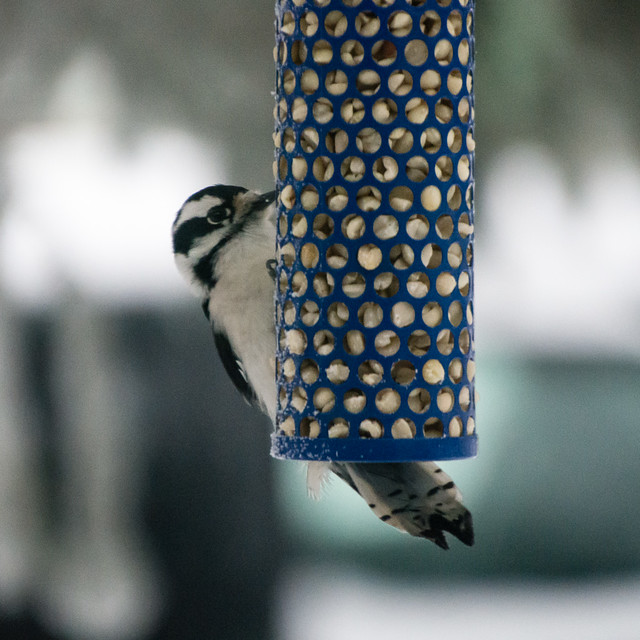I was sitting on the couch playing with a new lens I picked up this morning when I looked up and saw a squirrel in the tree outside our front window. Perfect chance to test out the lens!

It's unusual (for me at least) to see squirrels in Saskatoon. I wasn't too surprised to see it though, because the neighbors had mentioned seeing one around our bird feeder. This one didn't actually mange to get to the feeder while I was watching, but I might have to move it further away from the trunk to be safe! He/she was moderately cooperative - not letting me get too close, but not running away.

Although I was shooting upwards into the tree, I was far enough back that the angle was reasonable and the shots don't look too far off eye-level. I had a little trouble with exposure due to shooting against the bright sky. I tried exposure compensation first, which is what I'd normally use, but in this case I found using center weighted metering gave me the best results.

The lens is the new Tamron 18-400. On my Nikon 7200 that's the 35mm equivalent of 28-600mm. Previously I was using the Nikon 18-300 but I really liked the idea of getting a little more reach. And the Tamron is also better at shooting macro. Amazingly the Tamron does this with a lens that is more or less the same size. (Slightly longer but thinner.) This kind of lens really fits my opportunistic style of photography. One minute I might be photographing a bird, the next a landscape, and the next a tiny insect. It's perfect for travel where you don't want to carry a bunch of big lenses.
A super-zoom lens like this (22x) is always a compromise. It's not the brightest or sharpest compared to non-zoom prime lenses. So I was curious to see how my shots of the squirrel would turn out. It was a cloudy day and the squirrel was in the shadow of the branches, not ideal conditions. And as usual for me, it was handheld. But the eyes are sharp enough to see the trees reflected in them, and you can count the whiskers. I was pretty happy with the results. (Click on the photos to view larger.)

It's unusual (for me at least) to see squirrels in Saskatoon. I wasn't too surprised to see it though, because the neighbors had mentioned seeing one around our bird feeder. This one didn't actually mange to get to the feeder while I was watching, but I might have to move it further away from the trunk to be safe! He/she was moderately cooperative - not letting me get too close, but not running away.

Although I was shooting upwards into the tree, I was far enough back that the angle was reasonable and the shots don't look too far off eye-level. I had a little trouble with exposure due to shooting against the bright sky. I tried exposure compensation first, which is what I'd normally use, but in this case I found using center weighted metering gave me the best results.

The lens is the new Tamron 18-400. On my Nikon 7200 that's the 35mm equivalent of 28-600mm. Previously I was using the Nikon 18-300 but I really liked the idea of getting a little more reach. And the Tamron is also better at shooting macro. Amazingly the Tamron does this with a lens that is more or less the same size. (Slightly longer but thinner.) This kind of lens really fits my opportunistic style of photography. One minute I might be photographing a bird, the next a landscape, and the next a tiny insect. It's perfect for travel where you don't want to carry a bunch of big lenses.
A super-zoom lens like this (22x) is always a compromise. It's not the brightest or sharpest compared to non-zoom prime lenses. So I was curious to see how my shots of the squirrel would turn out. It was a cloudy day and the squirrel was in the shadow of the branches, not ideal conditions. And as usual for me, it was handheld. But the eyes are sharp enough to see the trees reflected in them, and you can count the whiskers. I was pretty happy with the results. (Click on the photos to view larger.)
















